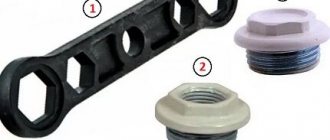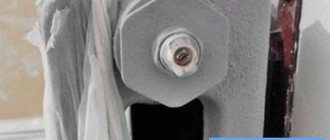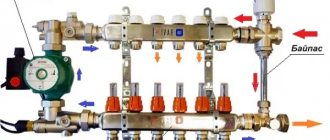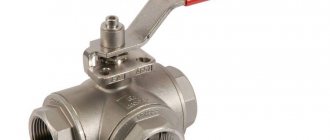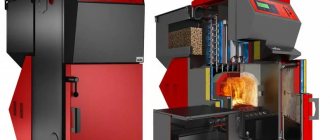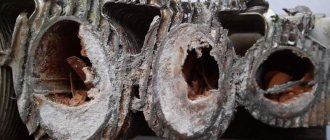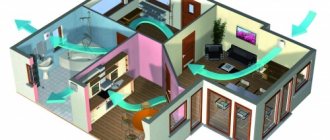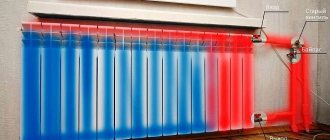Air valves shaped like radiator plugs
Lyrical digression. House owners and some “professionals” unknowingly call Mayevsky’s float valve an automated air vent, which is fundamentally wrong. In the 30s of the last century, the inventor Mayevsky proposed the design of a manual crane, but it has nothing to do with the “automatic machine”.
Where are the air release valves installed?
In any traditional heating system there are places where the installation of Mayevsky taps is mandatory. If we talk about air vents, then they must be installed on all batteries in order to bleed off the collected air. The exact location is in the plug in the upper corner, distant from the point where the supply line is connected to the device. An air bubble forms there.
If the boiler is equipped with a built-in Mayevsky tap, then it does not need to be installed on the supply side
The automated ventilation valve must be installed strictly vertically at the following points in the heating network:
- in the safety group of a boiler connected to a closed type system;
on two heated floor collectors;
In addition to the listed points, air vents are installed in problem areas of the heating network, where, due to difficult conditions for laying pipes, they form U-shaped loops turned upward. For example, the highway goes around the entrance opening or a flight of stairs at the top, and then goes down again. In similar compensators, air pockets appear with a 100% probability, so a Mayevsky crane is needed, preferably an automated one.
When a pipe or compensator is considered the highest point of the network, a valve is installed on it
Advice. Never cut the air vent directly into the pipeline, as bubbles will pass by it simultaneously with the flow of coolant and the valve will be useless. For normal operation, a manual “bleeder” needs a chamber to collect air (the “automatic” has its own). Make a vertical pipe into the main line, which will serve as an air collector, and install a faucet on top.
If, when filling the heating system with water, you do not want to run between heating devices with a screwdriver, replace Mayevsky valves with Mayevsky automated corner valves. This option is also suitable for residents of centrally heated apartments: air pockets often appear in cast iron radiators, and there is no way to remove them.
Another tip. To prevent the corner air vent flask from sticking out in plain sight and clinging to the curtains, you need to take a mini-model of the valve built into the radiator cap.
Instead of a conclusion - recommendations for choosing
The first and main recommendation is not to purchase automated “air ventilators” made in Asia. The results of similar savings are well known to heating supply specialists:
- simultaneously with the air, the product allows a coolant to pass through, causing drips to appear on the body and floor, and the pressure in the system decreases;
- a low-quality Mayevsky tap may jam and not work;
- the insides of the element very quickly fail under the influence of a heat carrier.
The situation with air vents is not very bad for one reason - there is nothing to break there. On the other hand, the product does not belong to complex heat exchange equipment and its price is absolutely affordable even from famous brands. For example, manufacturers Icma, Caleffi and Valtec recommend decent products in the mid-price category. The “machine guns” from the Spirotech brand, shown in the picture, have also become famous for their reliability.
Now we will give a number of recommendations for choosing air bleed valves:
- It is best to take the air vent with a handle so as not to bother with screwdrivers and keys. It is comfortable to turn it even in places where it is difficult to reach when the heating device is hidden in a niche.
- If small children live in a private house or apartment, place a manual tap under the screwdriver. A child can reach the handle, open the valve and be scalded by the heat carrier.
- If possible, take an automated valve with a shut-off valve. It will make it possible to remove a part at almost any time for the purpose of repair or replacement.
- The anodic coating of the housing does not play a special role during operation. It protects the metal from oxidation.
- The presence of additional functions that improve the performance of heat supply is welcome. If your budget allows, you need to take a Mayevsky faucet that catches bubbles.
The working principle of a deaerator is applied here - many components filling the chamber trap bubbles and direct them to the Mayevsky valve
Note. On sale there are combined shut-off valves and equipment equipped with a relief valve. This includes circular pumps, balancing valves and various taps. You should not focus on similar products; it is more convenient to buy and install any part of the circuit separately.
Float models of Mayevsky cranes are designed for a certain response pressure and coolant temperature. As an example, we recommend considering the table of technical specifications from the Italian brand Caleffi and making sure that 2 options are useful for installation in a personal home - the MINICAL and VALCAL product line (good response pressure - 2.5 and 4 Bar based on this).
For installation in an apartment connected to centralized heating, you need to take the ROBOCAL model, which is designed to operate at a pressure of 6 bar. Other honest manufacturers present similar tables with parameters according to which you can choose an automated “air vent”.
Design and principle of operation of the mechanism
The author of the effective and quickly gaining popularity device is the Belarusian plumber Roev.
In 1931, he designed a valve that allowed radiators to bleed air without unnecessary effort. But the design currently in use is an improved model of the bleeder valve. Engineer Ch.B. Mayevsky improved the invention of the worker Roev.
The device has improved sealing due to the “cone-in-cone” needle valve design. According to GOST, the name of the mechanism is a needle radiator air valve.
The device is controlled by a locking screw, which is adjusted from the outside, or by a screwdriver. In the closed position, the valve holds the coolant inside the battery.
When turning, a hole opens and air comes out through it.
Main parts of the crane:
- housing with inlet calibration and outlet drain holes,
- cone needle valve,
- sealing ring,
- valve or locking screw with a socket head or screwdriver.
Often asked
What is the best way to install a Mayevsky tap in aluminum radiators?
The best option would be a faucet in a stainless steel body, then an electrochemical aluminum-copper pair will not form.
Is a Mayevsky tap needed in an autonomous heating system without forced pumping?
It is advisable to provide an air vent in any heating system.
In an open system with an expansion tank, is it worth installing a Mayevsky tap?
In such a system it is quite possible to do without it.
There is no tee on the heated towel rail, what should I do?
Initially, this equipment is not installed on a tee. You need to disconnect the device from the system, install a tee, mount an air vent and connect a heated towel rail.
Removing air lock from radiators will significantly improve the efficiency of the heating system. The Mayevsky crane will definitely help here, it is easy to install and operate.
Types of devices
The design of the crane is different in individual modifications, but the principle of operation is identical. The classification is based on the location and principle of control of the mechanism: automatic or manual.
The following types of valves exist:
- Classic with carving . Installed on any part of the system if the circuit is tortuous. For installation, drill a hole and cut an internal thread. The descent is controlled manually in this model.
- Radiator . Metal tap with plastic cap. To bleed air, simply turn the handle and then return it to its original position. Modern radiators are often sold already equipped with valves.
- Ball . Mechanism for manually controlled hybrid heating systems. Instead of a screw, they have a rotating ball with an internal hole.
- Automatic . Equipped with a cylinder with a built-in float. When the cavity is filled with air, it is automatically released. The loss of pressure causes the float to move upward, as a result of which the outlet is blocked and the coolant does not drain. But this design is suitable for clean water. Centralized networks contain dirt, so installing automatic valves in them is problematic. Such mechanisms are installed in the home heating network, where the water is filtered.
- With safety valve . It is triggered automatically when the permissible pressure in the system is exceeded, which threatens pipe rupture. Typically these are above 16 bar. Installing such a device is especially important for a home system made of plastic pipes.
Bleeding air from the autonomous system can only be done when the circulation pump is turned off. When the pump is turned on, the air will not rise to the top of the radiator, but will be spread throughout the system and will not enter the valve.
Features of installing an air vent in a private house
You will need a wrench for installation.
An air vent designed for heating communications in a private home must be installed strictly in a vertical position. For installation work you will need a threaded tee, FUM tape, and an open-end wrench.
The installation process is carried out in stages:
- Tee fastening. You will need a piece of pipe onto which a tee is fixed by soldering, glue or simple shrinkage.
- Preliminary check of the location of the vent at the highest point of the equipment. The device connection must have an upward direction.
- Installing the shut-off valve on the hexagon of the device using an open-end wrench.
- Connect the automatic air vent so that the protective cap with nipple faces upward.
- Screw the cap tightly to prevent debris from accumulating.
- Checking the tilt of the device (for radiator models). The battery section with the drain rises slightly.
After installation, the devices do not need to be adjusted - they will bleed air automatically.
Features of a multi-stage scheme
The multi-stage deaeration scheme provides for the installation of automatic devices along the entire line. Connecting the vents in this way allows you to locally and simultaneously remove air pockets. The automatic device is placed in the zone of rotation, formation of a loop. To extend the service life of the valve, an additional filter is installed. Once assembled, the system operates with the radiator hot at the bottom but cold at the top.
In two-story houses, installation of diverter devices must be carried out on the top floor.
A corner, straight or radiator vent is suitable for the heating main of an apartment building or private building. The automatic device is simple, reliable and maintainable. After installing it, the owner does not have to waste time monitoring the system and manually bleeding air.
Criterias of choice
To decide whether the installation of a Mayevsky tap is necessary, consider whether the air can independently escape from the pipes and heating radiators. Consider the laws of physics: air can only flow upward from pipes and radiators. Based on this parameter, you can choose which device is better.
To select a suitable model, you should also take into account the material of the pipes, the availability of free access to the installation site and the nuances of servicing the mechanism.
Basic expert advice on selection criteria:
- In houses with centralized heating, it is advisable to install manual models or taps with fuses, which will help protect the system from water hammer. To prevent clogging, automatic taps can be installed in home systems where purified coolant circulates.
- Even in a home system, only manual taps can be installed on cast iron batteries.
- For plastic pipes, choose models with a fuse. This protects the mechanism from damage due to water hammer.
- In hard-to-reach places, it is worth installing an automatic model or a manual faucet with a valve.
- When purchasing a valve, it is important to pay attention to the material from which it is made. The design with a brass body will last the longest: this material is resistant to corrosion.
- The type of product, maximum load and compliance with the type of communications are reflected in the documentation for the model, so it is important to study the instructions when purchasing.
Mayevsky taps with valves should not be installed in rooms where there are small children!
Shut-off valves for heat supply
An example of piping radiators using taps and valves
All taps for radiators and pipelines operate on the general principle - using a shut-off element, they limit the flow of coolant in a specific section of pipelines. However, the speed and degree of adjustment of this process depend on the specific design of the shut-off valves.
First of all, for proper operation of the system, taps for heating radiators are necessary. Depending on the design of the locking element, they are divided into two types:
- Ball;
- Needle-shaped.
It must be remembered that during heating operation, situations may arise when it is necessary to completely limit the flow of coolant into radiators or a section of the pipeline. Ball valves are designed for this purpose. If smooth adjustment of the volume of incoming liquid is necessary, needle fittings are installed.
Control valves for heating are characterized not only by size and design data. Manufacturing materials have a great influence on the life and quality of their service.
Ball Valves
Ball valve design
If it is necessary to quickly shut off the water in a radiator or pipe section, ball valves should be installed. Their design consists of a spherical core with a through hole. It is connected to the control handle, through which the component operates.
Depending on the material of manufacture, you can install a polypropylene ball valve for heating or its steel analogue. It all depends on the heat supply area where it will be installed. In addition to this factor, when choosing, you need to take into account the type of connection. It can be intended for radiator taps or pipelines:
- Flanged . Used in highways of medium and large diameters. Mainly made of steel, its alloys or cast iron;
- Couplings . The most common type of polypropylene ball valves for heat supply. Connection to the pipe section occurs through a permanent connection or by soldering. An adhesive composition is rarely used to form an assembly assembly.
These taps for heating pipes are characterized by rapid shut-off of the coolant. It is enough to turn the control handle 90° to completely stop the movement of water into the main line or radiator.
During installation, the direction of movement of the coolant must be taken into account. All plastic ball valves for heating have a special indicator on the body.
Needle taps
Design of a needle valve
If smooth adjustment of the fluid flow is necessary, installation of needle valves for heating should be provided in the heating system. Their main difference from ball ones is the presence of a rod, which is lowered or raised using a threaded mechanism, thereby reducing the throughput in this section of the pipeline.
Depending on the application, this type of valve can be shut-off, regulating or balancing. The difference in design is determined by the shape of the needle rod and the characteristics of the threaded control element. Most taps for heating radiators have a standard design and are designed to smoothly regulate the flow of coolant.
When choosing, it is recommended to pay attention to the following characteristics of needle fittings for heat supply:
- Connection type – coupling or flange;
- The degree of adjustment of the rod position;
- Material of manufacture. In polypropylene pipes, the installation of plastic heating taps is required. If steel lines are installed in the system, then the shut-off valves should be selected from the same material. This will avoid differences in thermal expansion of the components.
The use of these structures as taps for draining water from the heating system is not recommended. In this case, ball models would be the best option.
All taps for heat supply batteries are designed for a certain maximum and optimal pressure. This characteristic must correspond to the calculated one. Otherwise, the system will depressurize.
Installation Rules
Self-installation of a Mayevsky crane is a simple process.
You need to select a mechanism that matches the diameter of the radiator plug. Currently, Mayevsky taps are produced with 1⁄2-inch, 3⁄4-inch and 1-inch threads. To install, remove the plug and screw the tap into its place.
When screwing in the faucet, install it so that the air vent hole is directed downward, at approximately an angle of 45 degrees.
This is advisable to make it more convenient to collect water after bleeding the air. To protect against leakage, additionally use linen winding or FUM tape.
Please note the following during installation:
- In a vertical thermal circuit, the mechanism is mounted in radiators on the top floor and on devices connected to the riser below the heating axis.
- In a horizontal system, taps must be installed in all devices. Complex network weaves will require several automatic and mechanical devices.
- The highest point in the floor radiator is selected, and the tap is placed with the screw facing up.
- Automation is installed in hard-to-reach places.
- Automatic taps are sensitive to temperatures that are too high. If the coolant heats up above 150 degrees, then it is preferable to choose a mechanical faucet.
- In heated towel rails with a bottom connection, the design provides space for installing a tap. In a model with a side connection, a tee is first cut in, and an air vent is mounted into it. It is advisable to equip a heated towel rail with a complex shape with several valves.
- When installing the valve, note that the plugs have left-hand threads. During dismantling, it is better to hold the plug with a gas or adjustable wrench so that it does not begin to unscrew along with the tap. To simplify the work, it is better to completely disconnect the cast-iron battery from the system and select a valve with a minimum external thread diameter.
Any alteration of the design of a centralized heating system that is not specified in GOST or SNiP must be agreed upon with the service organization. Otherwise, you put yourself and your neighbors at risk of emergency flooding.
The nuances of installation in a cast iron battery
Installing a faucet in an old-style radiator has some difficulties. Many craftsmen create a homemade faucet. Drill the fitting, cut the thread and screw in a simple bolt. The option is primitive and inconvenient, since when the bolt is loosened and air is released, an uncontrolled leak will form.
Therefore, it is more advisable to install the Mayevsky tap without unscrewing the stuck fitting:
- Buy a tap with a landing thread M 10 x 1 and prepare taps No. 1 and 2. A machine tap will not work, since cast iron is hard and the tool will break.
- Drain the water from the radiator and drill the top plug with a thin drill (5 mm), then break it with a drill with a diameter of 9 mm.
- Remove the chamfer. Cut the thread using taps No. 1 and 2 alternately.
- Seal the threads with flax, tighten and tighten the tap.
Do not drill cast iron or cut threads “dry”: this will quickly dull the working edge. Periodically lubricate the tool with machine oil,
Automatic air vent
There are mainly Italian and German models of automatic air vents on the market. These are Caleffi, Pettinaroli, Valtec, Watts, Oventrop and Flamco. The most commonly used air valves are the so-called float valve type.
Design
There is a float in a brass or stainless steel body. A simple hinge mechanism called a “rocker arm” is attached to it at one of the edges. A needle (rod) is attached to the other edge of the mechanism. When the body is filled with water, the needle is in a calm state and the valve remains closed. But as soon as air accumulates in the air vent body, the water level, and with it the float, drops. The needle together with the “yoke” begins to move. When the needle enters the spring-loaded spool, it presses on the rod, which, moving, opens the holes for air release. This is how an automatic air vent works.
In addition to the air valve, which is part of the boiler safety group, an automatic air vent should be installed at the highest point of the circuit. Installation can be done on both vertical and horizontal pipelines. To do this, the manufacturer makes the coolant supply to the air vent both lower end and lower radial. The operating position of the automatic air vent is always vertical.
To be able to remove the automatic air vent without emptying the entire system, its threaded part (G1/2″, G1/4″) is connected to the heating pipe through a shut-off valve.
This simple device consists of a boss with a plastic flap. When the air vent is screwed in, the damper automatically opens, and when unscrewed, it closes.
When installing the air vent, a regular open-end wrench is used; the lower part of the vent body is made in the shape of a hexagon. The air nipple cap must be closed during installation.
Valve malfunctions and solutions
Due to the high salt content of the coolant, the needle may become overgrown with scale and the air vent begins to leak. To clean the vent from scale and rust, unscrew it after first insulating and draining the water from part of the pipeline. If there is a cut-off valve on the fitting, the water is not drained. The valve is disassembled, washed, and the needle is carefully cleaned. During the assembly process, the body parts are sealed together.
To prevent the automatic air vent from becoming clogged, it makes sense to place a mechanical filter directly in front of it.
Very often the air vent is made collapsible. The connection between the body and the lid occurs through a special ring. If it breaks, it causes a leak. It is unlikely that you can buy such a ring at retail. It’s easier to use fum tape or silicone sealant.
If the air vent is mounted deviating from the vertical, it will leak. There is only one salvation - dismantle, plug the fitting and install it strictly vertically in a new place.
The cause of the leak may be a skewed float. It is easy to fix it yourself when disassembling it.
How to deflate
Procedure:
- Place a container under the tap to collect the flowing water.
- The locking screw is turned counterclockwise 90-180 degrees.
- Air will begin to escape from the battery with a characteristic hissing sound.
- As soon as water flows from the hole and the pressure stabilizes, the screw is turned in the opposite direction. Uniform flow means that there is no air left in the pipes.
If after lowering the batteries do not begin to warm up completely, it means they are clogged. You shouldn’t fix the problem yourself; it’s better to turn to specialists.
Drain valve with nozzle: technical features
We offer a significant range of shut-off valves from leading manufacturers. The company’s specialists recommend studying the main technical characteristics of the model before buying a drain valve. It is better to choose the following parameters:
- The sealing elements of the device must be made of fluoroplastic;
- Connection type – coupling;
- There must be a comfortable lever with additional PVC coating;
- The best solution would be a brass valve for bleeding air, since brass is not subject to corrosion and is a wear-resistant and durable material;
- The stem and ball must also be brass.
After studying the offered range, you can choose the best solution for your needs. If you have any questions, our specialists will not only answer them, but will also help you choose a brass drain valve in accordance with all your requests.
Rules of service
Uninterrupted operation of the drain valve is possible only if the rules for its operation are observed:
- To bleed air, open the tap. If the air flow does not stop after a few minutes, it means that there is an additional suction in the system. To check the tightness, take a thin sheet of paper and pass it around all the joints. In places where there is suction, the sheet will be drawn to the joint.
- If the exhaust channel is dirty, clean it with a thin needle or wire.
- With infrequent use, the faucet becomes corroded and stops working. To correct the situation, treat the faucet with WD-40. For preventive purposes, after the end of the season, the threads should be treated with silicone grease.
- The faucet cannot be repaired and must be replaced if broken. Dismantling must be done using an auxiliary adjustable wrench to fix the radiator cap. Otherwise, the radiator itself may be damaged.
When using an ion boiler with a closed coolant circulation system, the faucet will not last long. A brine solution is added to the coolant for such a system to ensure the acceleration of ions in the boiler. When bleeding air, salts will be deposited inside the valve, which will lead to failure. For ion boilers, devices are provided that are resistant to salt.
Questions and answers
Mayevsky's tap broke and several apartments were flooded. Who will be responsible: the owners of the apartment or the management company?
If the tap was not on the riser (or it was the first shut-off device after the riser) and was installed without approval, then the owner is responsible for it, according to Art. 210 of the Civil Code of the Russian Federation.
If the batteries are hot on top and very cold on the bottom, does it make sense to install a Mayevsky valve to bleed air?
Installing a faucet only helps remove air. If the battery is not connected correctly (this happens with a top connection) or is clogged, this procedure most likely will not help.
Mayevsky's faucet is leaking. How to fix?
A special seal is responsible for the tightness of the valve, and wear may be the cause of the leak. In this case, you will need to replace the seal or the entire valve. If drops occur in the thread area, the tap must be tightened with a wrench for a tighter fit. The leak may be due to a blockage.
I open the tap, but there is no air or water. What is the reason?
If the heating system is working properly and there is enough coolant inside, the reason is that the tap hole is clogged. It needs to be cleaned or the tap replaced.
Installing a Mayevsky crane on a heating system significantly simplifies its operation and increases operating efficiency.
The installation process is not complicated and can easily be done with your own hands. But selecting the appropriate valve model requires the use of some knowledge, so it is better to consult with specialists. During operation, it is important to follow the rules and periodically carry out preventive maintenance to maintain the functionality of the mechanism.
Valve or drain pipe
Now let's decide whether a vacuum valve can completely replace a drain pipe. We will also break this question into two:
Is it possible to equip the sewerage system in a private house with a valve instead of ventilation? Is it possible to dismantle the sewer riser on the top floor of an apartment building above the cross or tee with your own hands and install a vent valve instead?
A private house
Installing a valve instead of ventilation is possible, but not advisable. Why?
- There is no escape from the draft created in the risers. The slightest violation of the tightness of the sewer - and the smells of sewage will begin to saturate the kitchen and bathroom. When ventilation is running, any gap between the plumbing fittings and the pipe socket will, on the contrary, draw air out of the corresponding rooms;
- When connected to a central sewer, the drain pipe facilitates ventilation of the manhole through the outlet. In particular, the methane content drops under the lid. The argument is not far-fetched: every year several people die from suffocation in a well;
- If you use a septic tank, its ventilation through the septic pipe will promote the activation of aerobic bacteria and, therefore, better processing of wastewater with a reduction in solid sediment and odors.
Apartment house
I strongly do not recommend disassembling the riser outlet onto the roof. Even with replacing the drain pipe with a vacuum valve. You see, the benefit from such a solution will only be the opportunity to make the cabinet above the toilet a little more spacious; but the righteous anger of the neighbors below, the housing organization and representatives of the municipality will fall on your head.
Why?
The mechanism in brief is:
- After dismantling the drain pipe and installing the valve, the ventilation of the riser will stop, but the draft in it will not go away. Meanwhile, the connections between washbasins and combs in most apartments are leaky. The sudden appearance of amber will arouse the interest of residents on the floors below you and a bunch of complaints to the housing office or management company;
- When a mechanic comes to a call, the first thing he does is inspect the outlet of the vent pipe to the roof. After making sure that it is missing or cut off at the attic level, he will pay a visit to the top floor - to you;
- Based on the results of the inspection of the riser, an act will be drawn up on the unauthorized reconstruction of utilities, affecting the interests of other residents;
- The consequence will be an order to restore the original configuration of the riser with the possible imposition of an administrative penalty.
